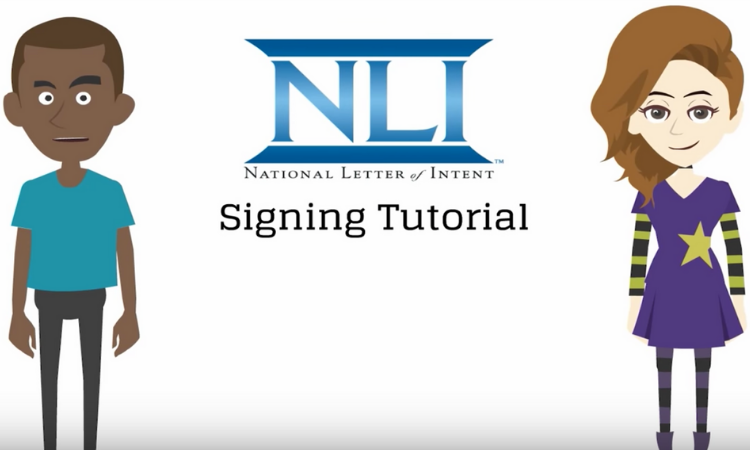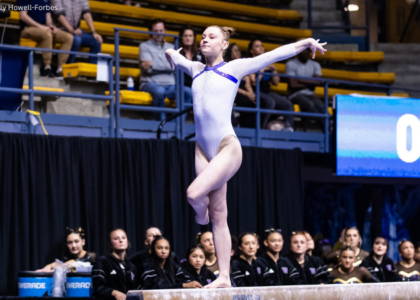It happens every year. Gymnasts sit down at a tablecloth-covered table adorned with the their future school colors, a cake decorated with their chosen institution’s logo or mascot, a picture representing their accomplishments. They grab a pen, straighten papers and pose for pictures. Then they sign.
It’s a ritual we all know well. Many gymnasts often grow up watching the big girls and boys on their signing day, dreaming of one day doing the same. But what exactly are they doing? What are they signing? What does it mean? We’re here to break down all those questions and more.
For more information on the National Letter of Intent, visit NationalLetter.org.
What all is included in an NLI?
National Letters of Intent must include an offer for athletics financial aid for the entire academic year, which comes out to two semesters or three quarters. For an NLI to be valid, it must include an athletics financial aid award letter, detailing “the terms and conditions of the award, including the amount of the financial aid.”
When can gymnasts sign?
Gymnastics’ signing day begins November 14, 2018 and extends until August 1, 2019. During this period, gymnasts that have been offered scholarships and that are graduating in 2019 sign a binding agreement called a National Letter of Intent. They must sign within this period and must sign within a week of receiving the documents.
These gymnasts are then required to enroll in the university within a year of the signing date—most will have the intention to compete their first season in 2020, but a few will join early for 2019 while others will defer to a future season due to Olympic aspirations, for example.
The gymnasts’ future coach(es) can’t be present at the signing unless it occurs on campus.
What does it mean to sign?
When signing an NLI the gymnast “agrees to attend the institution listed on the NLI for one academic year in exchange for that institution awarding athletics financial aid for one academic year.” Simply completing the competition season wouldn’t fulfill the NLI.
Does everyone planning to join a team sign?
No.
Gymnasts planning to walk-on to a team do not sign NLI (see “What all is included in an NLI?”). Gymnasts joining DIII teams, military academies or Ivy League schools also do not sign an NLI. Only NLI member institutions’ athletes sign NLI’s.
Gymnasts also do not sign an NLI if they are transferring from one four-year institution to another four-year institution. However, someone who was at a four-year institution, transferred to a two-year institution and is planning to transfer to another four-year institution may sign an NLI.
Do walk-ons sign NLI’s?
No. Often you will see gymnasts intending to walk-on to a team (or go to DIII, Ivies or military academies) signing something, but it is not an NLI but likely an agreement to enroll or other similar document that allows the gymnast to participate in signing day festivities.
Does a gymnast have to be NCAA eligible to sign an NLI?
No. Gymnasts can sign before they receive official confirmation from the Eligibility Center, but signing essentially says you agree to “submit the necessary information and documents” that would deem you eligible to compete. If later the gymnast is deemed ineligible, their NLI is declared null and void.
Can gymnasts be released from signing if there’s a coaching change?
Yes, however there is no obligation for the gymnast to be released due to this reason as the signing is with the institution and not the specific coach or even the specific sport. The binding NLI does not break just because of a coaching change. The gymnast must request to be released first.
If a gymnast quits or leaves the team, is the NLI still binding?
Yes, the gymnast must remain at the institution for an entire academic year regardless of being on the team or not. If he or she wishes to leave, they must request a release.
Does a gymnast have to sign an NLI to be on scholarship?
No, a gymnast is not required to sign an NLI, but he or she does have to sign an aid agreement. However, most gymnasts do sign an NLI “to create certainty in the recruiting process.” Once a gymnast signs, he or she can no longer be actively recruited by other institutions. After this milestone, “any contact in excess of an exchange of a greeting is not permitted regardless of the conversation.”
What does it mean to grayshirt?
Grayshirting simply means the gymnasts decides to defer enrollment at the NLI institution until the winter or spring term, after when the traditional school year starts.
If a gymnast decides not to attend the institution where they signed their NLI, what are the rules for them being recruited elsewhere?
They must have been given a complete released from the NLI they signed or had the “NLI recruiting ban” lifted. To do this, the gymnast has to fill out a “NLI Release Request Form.”
Does a gymnast sign an NLI every year?
No. However, the gymnast must be notified each year about whether or not his or her athletic aid has been renewed.
In what circumstances can a gymnast be released from an NLI?
A gymnast may be granted a release from their NLI due to extenuating circumstances. This would not include a coaching change. However, some viable examples could include “illness of the student, illness or death of a parent or financial hardship of the student’s family which prevent the student from attending the signing institution.” The NLI can also be deemed null and void if the institution discontinues the sport.
The institution is not required to release the gymnast if it doesn’t want to.
If a gymnast decides after signing he or she doesn’t want to attend the institution but is not granted a release, the penalty is that they “lose one year of competition in all sports and must serve one year in residence at your next NLI institution.” That penalty only applies if the gymnast want to attend another NLI institution; meaning if he or she decides instead to attend a DIII, military academy or Ivy League school, they would not have to sit out a year.
During this “year in residence,” gymnasts are permitted to receive aid and practice with the team if the institution allows it.
READ THIS NEXT: 10 Uncommitted 2019 Graduates to Keep an Eye On
Article by Elizabeth Grimsley
Like what you see? Consider donating to support our efforts throughout the year!




5 comments